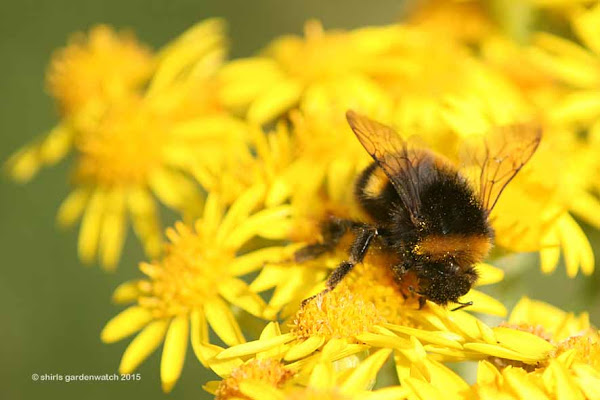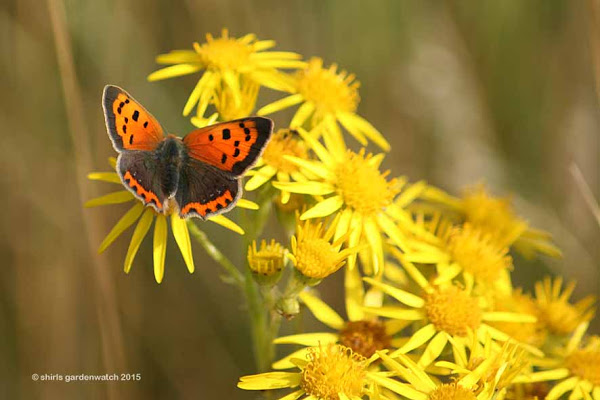When choosing a family day out on a sunny day here in the UK, if it’s within driving distance, many will choose the beach. Wildlife moments can be found by rock pooling but sand dunes are also a great place for wildlife discoveries – taking gardenwatch on tour again 🙂
Just as in our gardens, once you start looking more closely there’s so much to see and you wonder how you have missed it all before. Ragwort was the big surprise for me.
Mid-August 2015, gardenwatch location: Along the grassy dunes of Kilshanny Beach, Tenstmuir Forest just north of St Andrews. Subject camera was looking for: Dragonflies and the caterpillars of the Cinnabar Moth. Success: No to Dragonflies, water strip sightings seen previously were overgrown. Yes to caterpillars, although only odd ones spotted in area of the dunes searched.
Bees were the success story of this location – they were everywhere feeding on a huge haze of waist height, yellow Ragwort flowers! This was a very bright, sunny day and the sight was quite mesmerising. On a dull, wet day it would have been quite different.
The small copper butterfly has always been too quick for my camera on previous visits at this location. However on this day, it too was out enjoying the sunshine and feeding on the ragwort. I was delighted to get a proper look at this pretty little butterfly with its wings open as it is usually almost invisible with its wings folded resting on the sand.
Yay… the return walk back to the car saw a yellow and black striped cinnabar moth caterpillar playing hide and seek with me! Clearly it had few friends as the plant was looking very healthy. Yep… you’ve guessed it… ragwort is a food plant for cinnabar moth caterpillars. Since seeing great numbers feeding on this plant last July (stripping it almost bare) I always find myself taking a closer look.
A Small tortoiseshell butterfly was spotted feeding on ragwort last year when I had my video camera out trying to capture the caterpillars moving about en masse. I’ve a great clip that looks like the butterfly deliberately knocked away a caterpillar that had spent ages getting to the top. I must take a search for that and upload it 🙂
The shot of this trip has to be the absolutely stunning Peacock butterfly below which looks like I have photoshopped it on to a background of ragwort! It too was feeding on the ragwort and I had never seen this on previous visits. It’s brilliant to get surprise sightings when on tour 😉
As much as I love seeing ragwort along the sand dunes of our family favourite beach, I cringe a little when I see great swathes of it in roadside fields as a drive around countryside roads.
Joining all its wild, weed friends Ragwort (Senecio spp.) is seen growing happily in uncultivated ground like roadsides, railway embankments as well as grassy sand dunes. It isn’t seen as a problem in gardens but the story is a quite different one for farmers of cattle (horse owners too) as it is poisonous to these animals and a serious issue as it readily pops up in grazing fields.
As a gardener, when adding wild flowers to my garden plantings, I try to consider what is reasonable to grow in a small rural garden and pick locations within my garden that don’t go near boundaries so my plants don’t seed in my neighbour’s gardens. If ragwort ever found its way (over my hedge) into my garden I would be diligent in removing it and wouldn’t encourage wildlife gardeners to grow it.
Wildflower, Bird’s-foot-trefoil growing pond side in garden, mid-June.
Ragwort gets much discussion here in the UK but as with all wildlife, when a food plant is eradicated completely it does have a serious impact on the survival of a species and that’s not acceptable either. Farmers and horse owners need support in finding a solution – good luck to them. To a degree, it’s possible habitat loss on both sides.
Oh dear, this was supposed to be a light, sunny post on a rainy Friday night! Returning to sunny thoughts with blooming gardens full of food plants for bees, butterflies and other pollinating insects – tomorrow is Garden Bloggers’ Bloom Day! Yep, it’s that time of the month when Carol at May Dreams Gardens invites fellow bloggers to post on what’s flowering on the 15th. Happy GBBD to all taking part 🙂
Wishing everyone a great weekend for gardening, wildlife watching and getting out and about! Do remember though… if you go down to the beach this weekend… you’re sure of a big surprise for every ragwort that you might see… there’s sure to be… much wildlife having a picnic 😉
This post was published by Shirley for shirls gardenwatch in August 2015.








Hi Shirl! a lovely read and some cracking photos. Balanced enough I'd hope to keep everyone happy. Ragwort has it's place and benefits invertebrates but is a worry in or near grazing and land used to produce hay/silage. Thanks for giving the cautionary advice.
Sue
Oh my Shirley. You have some gorgeous photos of insects here. Love em.
Ragwort is one of those plants that divide opinion, it is I believe still a notifiable weed that should be destroyed, although as you say, driving around the highways you would not think so. Does the cinnabar moth caterpillar feed on any other related plant?
Beautiful peacock – we usually have loads on our buddleias but have seen hardly any yet this year
Hello everyone, thanks for all your comments 🙂
Sue, hello and thanks for stopping by! Yes, this isn’t a black and white story is it 🙂
Lisa, I had a lucky break on not changing camera settings to get this haze of yellow that made the insects shine out 🙂
Brian, when you see the ragwort after a big group of these caterpillars have been feeding there is practically nothing left but the main stem. You’d think they could sort out the problem for the farmers but it seems (like us pruning) they can push the plant into coming back with more growth but after seeing the weak stems in the sand I just can’t see it. I believe ragwort is listed as the main food plant for this moth so I guess other plants could be used if it was wiped out but numbers would probably decline.
Sue, that peacock just didn’t look real when I uploaded it! I remember your previous posts on not being able to count the butterflies on your buddleja’s. I was wondering if Ragwort is a problem at allotments?